Journal Description
Receptors
Receptors
is an international, peer-reviewed, open access journal on all aspects of receptors published quarterly online by MDPI.
- Open Access— free for readers, with article processing charges (APC) paid by authors or their institutions.
- Rapid Publication: first decisions in 16 days; acceptance to publication in 5.8 days (median values for MDPI journals in the second half of 2023).
- Recognition of Reviewers: APC discount vouchers, optional signed peer review and reviewer names are published annually in the journal.
- Receptors is a companion journal of Biomolecules.
Latest Articles
Dopamine D1–D5 Receptors in Brain Nuclei: Implications for Health and Disease
Receptors 2024, 3(2), 155-181; https://doi.org/10.3390/receptors3020009 - 12 Apr 2024
Abstract
Understanding the intricate role of dopamine D1–D5 receptors is pivotal in addressing the challenges posed by the aging global population, as well as by social stress and advancing therapeutic interventions. Central to diverse brain functions such as movement, cognition, motivation, and reward, dopamine
[...] Read more.
Understanding the intricate role of dopamine D1–D5 receptors is pivotal in addressing the challenges posed by the aging global population, as well as by social stress and advancing therapeutic interventions. Central to diverse brain functions such as movement, cognition, motivation, and reward, dopamine receptors are ubiquitously distributed across various brain nuclei. This comprehensive review explores the nuanced functions of each dopamine receptor, D1, D2, D3, D4, and D5, in distinct brain regions, elucidating the alterations witnessed in several neurological and psychiatric disorders. From the substantia nigra and ventral tegmental area, crucial for motor control and reward processing, to the limbic system influencing emotional responses, motivation, and cognitive functions, each brain nucleus reveals a specific involvement of dopamine receptors. In addition, genetic variations in dopamine receptors affect the risk of developing schizophrenia and parkinsonism. The review further investigates the physiological significance and pathogenic impacts of dopamine receptors in critical areas like the prefrontal cortex, hypothalamus, and striatum. By unraveling the complexities of dopamine receptor biology, especially those focused on different brain nuclei, this review provides a foundation for understanding their varied roles in health and disease, which is essential for the development of targeted therapeutic strategies aimed at mitigating the impact of aging and mental health on neurological well-being.
Full article
Open AccessReview
Exploring Emerging Therapeutic Targets and Opportunities in Neuroendocrine Tumors: Updates on Receptor Tyrosine Kinases
by
Lara Toffoli, Angeliki Ditsiou and Teresa Gagliano
Receptors 2024, 3(2), 145-154; https://doi.org/10.3390/receptors3020008 - 05 Apr 2024
Abstract
►▼
Show Figures
Neuroendocrine tumors (NETs) represent a diverse group of neoplasms originating from neuroendocrine cells, presenting varied clinical behaviors and posing significant challenges in management. This review explores the emerging roles of receptor tyrosine kinases (RTKs) in the pathogenesis and progression of NETs, including vascular
[...] Read more.
Neuroendocrine tumors (NETs) represent a diverse group of neoplasms originating from neuroendocrine cells, presenting varied clinical behaviors and posing significant challenges in management. This review explores the emerging roles of receptor tyrosine kinases (RTKs) in the pathogenesis and progression of NETs, including vascular endothelial growth factor receptors (VEGFRs), insulin-like growth factor receptors (IGF-1R), RET, epidermal growth factor receptor (EGFR), and ALK. The dysregulation of RTK signaling pathways contributes to key cellular processes such as proliferation, survival, and invasion in NETs. We discuss the potential of targeting RTKs as therapeutic strategies in NETs, with a focus on recent developments in RET inhibitors and the therapeutic implications of RTK alterations.
Full article
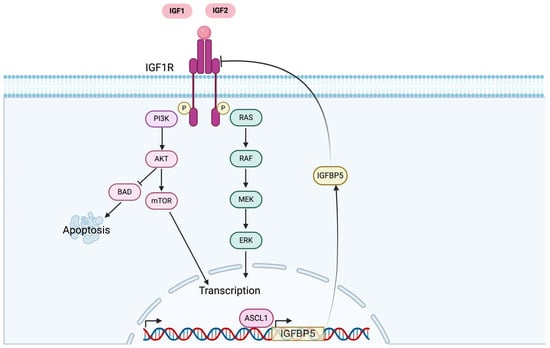
Figure 1
Open AccessReview
Molecular Targets for Cannabinoids in Natural Killer Cells: Do They Modulate the Antitumor Activity?
by
Miguel Olivas-Aguirre, Cecilia Gutiérrez-Iñiguez, Igor Pottosin and Oxana Dobrovinskaya
Receptors 2024, 3(2), 122-144; https://doi.org/10.3390/receptors3020007 - 25 Mar 2024
Abstract
Recent research has emphasized the potential of natural and synthetic cannabinoids as anticancer agents. Yet it remains unclear whether and in which sense cannabinoids affect the anticancer activity of NK cells, an important branch of anticancer immunity. Similar uncertainty exists regarding NK cells-based
[...] Read more.
Recent research has emphasized the potential of natural and synthetic cannabinoids as anticancer agents. Yet it remains unclear whether and in which sense cannabinoids affect the anticancer activity of NK cells, an important branch of anticancer immunity. Similar uncertainty exists regarding NK cells-based immunotherapy. Here we presented an overview of multiple cannabinoid targets as canonical (mainly CB2) and non-canonical receptors, ion channels, transporters, and enzymes, expressed in NK cells, along with underlying molecular mechanisms. Through them, cannabinoids can affect viability, proliferation, migration, cytokine production, and the overall anticancer activity of NK cells. Respective holistic studies are limited, and, mostly, are phenomenological, not linking observed effects with certain molecular targets. Another problem of existing studies is the lack of standardisation, so that diverse cannabinoids at variable concentrations and ways of administration are applied, and often, instead of purified NK cells, the whole lymphocyte population is used. Therefore, there is an urgent need for more focused, systemic, and in-depth studies of the impact of the cannabinoid toolkit on NK cell function, to critically address the compatibility and potential synergies between NK activity and cannabinoid utilization in the realm of anticancer interventions.
Full article
(This article belongs to the Special Issue Understanding Cannabinoid Receptor Signaling Complexity: Keys for Improved Therapeutic Drug Development)
►▼
Show Figures
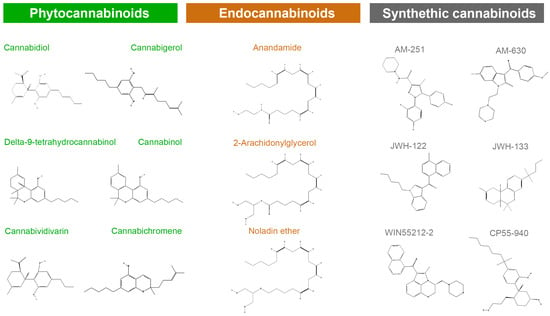
Figure 1
Open AccessReview
Fundamental Mechanisms in Membrane Receptology: Old Paradigms, New Concepts and Perspectives
by
Jacques Fantini
Receptors 2024, 3(1), 107-121; https://doi.org/10.3390/receptors3010006 - 18 Mar 2024
Abstract
►▼
Show Figures
Receptology, the science of receptors, is a multidimensional field of research which can be dissected into biosynthesis, membrane sorting, ligand binding and signal transduction. Plasma membrane receptors connect the cells with their environment and transmit signals that are translated into biological information. The
[...] Read more.
Receptology, the science of receptors, is a multidimensional field of research which can be dissected into biosynthesis, membrane sorting, ligand binding and signal transduction. Plasma membrane receptors connect the cells with their environment and transmit signals that are translated into biological information. The historical paradigm of ligand–receptor interactions is the lock-and-key model. This model presupposes that both partners have a precise 3D shape that perfectly fits together to form the ligand–receptor complex. However, this simple model suffers from severe limitations due to several levels of simplifications: (i) water molecules and membrane lipids are not considered; (ii) not all ligands have a stable 3D structure; (iii) the ligand-binding pocket of the receptor is often flexible and conformationally rearranged after the initial binding step (induced fit mechanism) and/or subjected to conformational selection by the ligand; (iv) there are signal transduction mechanisms which can be either purely mechanical (conformational change of the receptor induced after binding of the ligand), lipid-assisted (e.g., by raft lipids such as cholesterol or gangliosides), or in some instances of quantic nature (detection of odorant molecules). The aim of the present review is to challenge the old paradigms and present new concepts of membrane receptology that consider the impact of critical parameters such as water molecules, membrane lipids, electrostatic surface potential and quantum mechanisms.
Full article
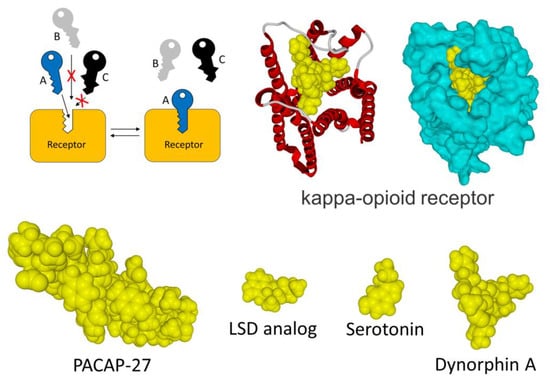
Figure 1
Open AccessReview
Role and Function of Receptor Tyrosine Kinases in BRAF Mutant Cancers
by
Bernhard Biersack, Lubna Tahtamouni and Michael Höpfner
Receptors 2024, 3(1), 58-106; https://doi.org/10.3390/receptors3010005 - 04 Mar 2024
Abstract
►▼
Show Figures
The development of potent BRAF inhibitors has revolutionized the treatment of BRAF mutant cancers, in particular, melanomas. However, BRAF mutant cancers of other entities, e.g., colorectal cancers, display distinctly reduced responses to BRAF inhibitors. In addition, the emergence of cancer resistance to BRAF
[...] Read more.
The development of potent BRAF inhibitors has revolutionized the treatment of BRAF mutant cancers, in particular, melanomas. However, BRAF mutant cancers of other entities, e.g., colorectal cancers, display distinctly reduced responses to BRAF inhibitors. In addition, the emergence of cancer resistance to BRAF inhibitor treatment poses a severe problem. The reactivation of MAPK/ERK signaling was identified as an important mode of BRAF inhibitor resistance. Receptor tyrosine kinases (RTKs), which are prominent anticancer drug targets in their own right, play a crucial role in the development of drug resistance to BRAF inhibitors and the reactivation of MAPK/ERK signal transduction, as well as the establishment of bypassing signaling pathways. MAPK reactivation can occur via increased expression of RTKs, altered RTK signaling, and post-translational processes, among others. This review summarizes the influence of pertinent RTKs on BRAF mutant cancers and BRAF inhibitor resistance and outlines possible and proven ways to circumvent BRAF-associated resistance mechanisms.
Full article
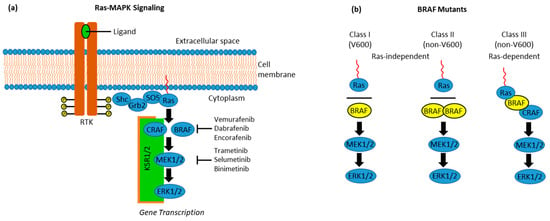
Figure 1
Open AccessArticle
D1-Like and D2-Like Dopamine Receptors in the Rat Prefrontal Cortex: Impacts of Genetic Generalized Epilepsies and Social Behavioral Deficits
by
Lidia M. Birioukova, Gilles van Luijtelaar and Inna S. Midzyanovskaya
Receptors 2024, 3(1), 36-57; https://doi.org/10.3390/receptors3010004 - 20 Feb 2024
Abstract
►▼
Show Figures
The involvement of the prefrontal cortical dopaminergic system in the psychopathology of epilepsies and comorbid conditions such as autism spectrum disorder (ASD) still needs to be explored. We used autoradiography to study the D1-like (D1DR) and D2-like (D2DR) receptor binding density in the
[...] Read more.
The involvement of the prefrontal cortical dopaminergic system in the psychopathology of epilepsies and comorbid conditions such as autism spectrum disorder (ASD) still needs to be explored. We used autoradiography to study the D1-like (D1DR) and D2-like (D2DR) receptor binding density in the prefrontal cortex of normal Wistar rats and Wistar-derived strains with generalized convulsive and/or non-convulsive epilepsy. WAG/Rij rats served as a model for non-convulsive absence epilepsy, WAG/Rij-AGS as a model of mixed convulsive/non-convulsive form, and KM strain was a model for convulsive epilepsy comorbid with an ASD-like behavioral phenotype. The prefrontal cortex of rats with any epileptic pathology studied demonstrated profound decreases in binding densities to both D1DR and D2DR; the effects were localized in the primary and secondary anterior cingulate cortices, and adjacent regions. The local decreased D1DR and D2DR binding densities were independent of (not correlated with) each other. The particular group of epileptic rats with an ASD-like phenotype (KM strain) displayed changes in the lateral prefrontal cortex: D1DR were lowered, whereas D2DR were elevated, in the dysgranular insular cortex and adjacent regions. Thus, epilepsy-related changes in the dopaminergic system of the rat archeocortex were localized in the medial prefrontal regions, whereas ASD-related changes were seen in the lateral prefrontal aspects. The findings point to putative local dopaminergic dysfunctions, associated with generalized epilepsies and/or ASD.
Full article
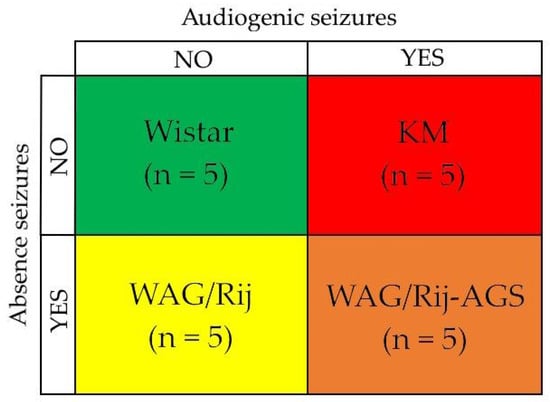
Figure 1
Open AccessPerspective
The Glucocorticoid Receptor’s tau1c Activation Domain 35 Years on—Making Order out of Disorder
by
Anthony P. H. Wright
Receptors 2024, 3(1), 27-35; https://doi.org/10.3390/receptors3010003 - 05 Feb 2024
Abstract
Almost exactly 35 years after starting to work with the human glucocorticoid receptor (hGR), it is interesting for me to re-evaluate the data and results obtained in the 1980s–1990s with the benefit of current knowledge. What was understood then and how can modern
[...] Read more.
Almost exactly 35 years after starting to work with the human glucocorticoid receptor (hGR), it is interesting for me to re-evaluate the data and results obtained in the 1980s–1990s with the benefit of current knowledge. What was understood then and how can modern perspectives increase that understanding? The hGR’s tau1c activation domain that we delineated was an enigmatic protein domain. It was apparently devoid of secondary and tertiary protein structures but nonetheless maintained gene activation activity in the absence of other hGR domains, not only in human cells but also in yeast, which is evolutionarily very divergent from humans and which does not contain hGR or other nuclear receptors. We now know that the basic machinery of cells is much more conserved across evolution than was previously thought, so the hGR’s tau1c domain was able to utilise transcription machinery components that were conserved between humans and yeast. Further, we can now see that structure–function aspects of the tau1c domain conform to a general mechanistic framework, such as the acidic exposure model, that has been proposed for many activation domains. As for many transcription factor activation domains, it is now clear that tau1c activity requires regions of transient secondary structure. We now know that there is a tendency for positive Darwinian selection to target intrinsically disordered protein domains. It will be interesting to study the distribution and nature of the many single nucleotide variants of the hGR in this respect.
Full article
(This article belongs to the Special Issue Nuclear Receptors: Honorary Special Issue Commemorating the Work of Prof. Jan-Åke Gustafsson)
►▼
Show Figures
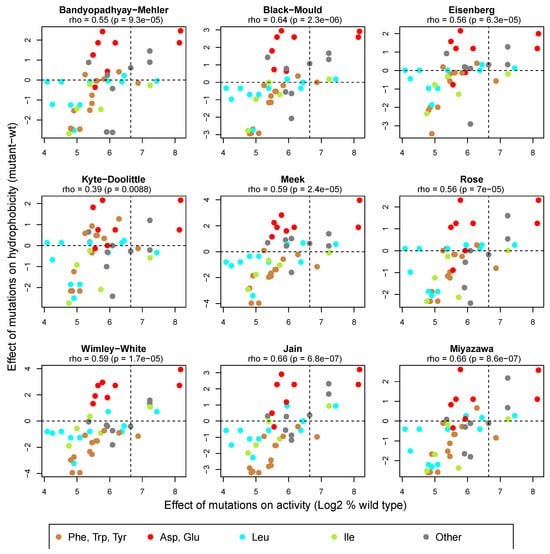
Figure 1
Open AccessReview
Biased Agonism or “Biaism” for Dummies: A Commentary
by
Jean A. Boutin and Jérôme Leprince
Receptors 2024, 3(1), 13-26; https://doi.org/10.3390/receptors3010002 - 25 Jan 2024
Cited by 1
Abstract
►▼
Show Figures
That signaling bias is a nth level of complexity in the understanding of G protein-coupled receptor (GPCR) activation is a first fact. That its exhaustive description, including the mode d’emploi of its quantitative measurement, remains a challenge is a second fact. That
[...] Read more.
That signaling bias is a nth level of complexity in the understanding of G protein-coupled receptor (GPCR) activation is a first fact. That its exhaustive description, including the mode d’emploi of its quantitative measurement, remains a challenge is a second fact. That the use of this concept is promising for the design of drug candidates is a third fact. That the translation of signaling biases observed into in vivo specific effects is well documented is a fourth fact. However, the road to apply those aspects of receptology to a systematic description of a ligand and, a fortiori, of a drug candidate, still necessitates a huge body of studies. In the present commentary, the merits of the molecular description of receptor bias signaling are highlighted and the ligand induced-fit impact on GPCR structure, as well as on the functional repertoire of GPCRs, is discussed. An emphasis is given to the practical aspects during drug design, and, thus, the practical limitations of the current approaches, particularly in the context of as soon as the data are transferred to more integrated/living systems, might be a major limitation.
Full article
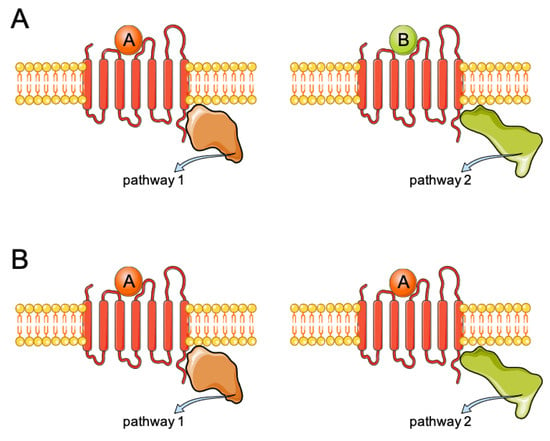
Figure 1
Open AccessArticle
Regulation of Hippocampal GABAergic Transmission by Fluoxetine and Its Metabolite Norfluoxetine
by
Elizabeth Vázquez-Gómez, Andy Hernández-Abrego, Jassiel Mejía-Piedras and Jesús García-Colunga
Receptors 2024, 3(1), 1-12; https://doi.org/10.3390/receptors3010001 - 04 Jan 2024
Abstract
►▼
Show Figures
Major depression is related to dysfunction of the GABAergic pathway. Interestingly, the antidepressant fluoxetine modifies GABAergic neurotransmission in human and animal models of depression. However, the effects of norfluoxetine (the main metabolite of fluoxetine) on GABAergic neurotransmission have not yet been studied. Therefore,
[...] Read more.
Major depression is related to dysfunction of the GABAergic pathway. Interestingly, the antidepressant fluoxetine modifies GABAergic neurotransmission in human and animal models of depression. However, the effects of norfluoxetine (the main metabolite of fluoxetine) on GABAergic neurotransmission have not yet been studied. Therefore, we explored whether fluoxetine and/or norfluoxetine may regulate GABAergic transmission and whether these substances interact with GABAA receptors in hippocampal CA1 stratum radiatum interneurons. For these purposes, we recorded the firing profile, GABAergic spontaneous inhibitory postsynaptic currents (sIPSCs), and currents induced by GABA puffs in stratum radiatum interneurons using both whole-cell current- and voltage-clamp techniques. Interneurons were selected according with their high firing profile. We found that both fluoxetine and norfluoxetine (at 20 µM) significantly decreased the frequency of sIPSCs without modifying their amplitude and decreased the amplitude of GABA-induced currents. These results indicate that fluoxetine and norfluoxetine decrease GABA release from neurons contacting stratum radiatum interneurons and negatively modulate GABAA receptors in these interneurons, resulting in their disinhibition, which in turn may contribute to increasing the inhibition of hippocampal CA1 pyramidal neurons.
Full article
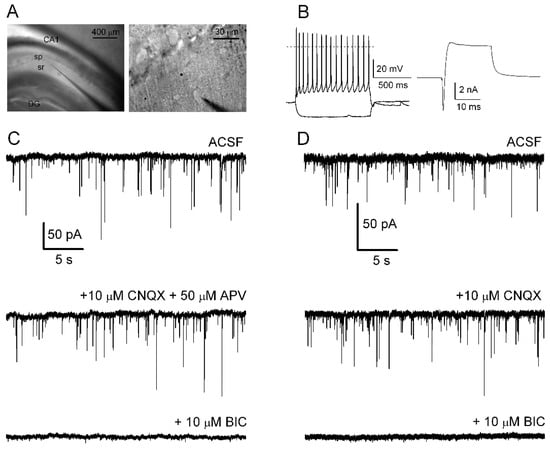
Figure 1
Open AccessArticle
The NR4A Orphan Receptor Modulator C-DIM12 Selectively Alters Inflammatory Mediators in Myeloid Cells
by
Sarah Aldhafiri, Mariam Marai, Mohamed Ismaiel, Brenda Murphy, Hugh E. Giffney, Thomas J. Hall, Evelyn P. Murphy, Eoin P. Cummins and Daniel Crean
Receptors 2023, 2(4), 264-283; https://doi.org/10.3390/receptors2040018 - 18 Dec 2023
Abstract
►▼
Show Figures
Orphan nuclear receptor subfamily 4A (NR4A) are key regulators of inflammatory responses, largely by their interactions with NF-κB. Over the last decade, several NR4A modulators have been developed, and they are showing potential as therapeutics, although their widespread use in laboratory settings is
[...] Read more.
Orphan nuclear receptor subfamily 4A (NR4A) are key regulators of inflammatory responses, largely by their interactions with NF-κB. Over the last decade, several NR4A modulators have been developed, and they are showing potential as therapeutics, although their widespread use in laboratory settings is limited. Here, we have examined, using myeloid cell line THP-1, whether the NR4A modulator 3-[(4-Chlorophenyl)-(1H-indol-3-yl)methyl]-1H-indole (C-DIM12) can alter the inflammatory outcome of six inflammatory ligands: lipopolysaccharide (LPS), tumour necrosis factor alpha (TNFα), interleukin-1 beta (IL-1β), flagellin (FL), lipoteichoic acid (LTA), and zymosan (ZY). We demonstrate that C-DIM12 (10 µM) selectively alters the secretion of inflammatory chemokine MCP-1 following exposure to distinct inflammatory ligands in a concentration-dependent manner. Furthermore, data obtained from THP-1 Lucia cell experiments show that 10 µM C-DIM12, and not 1 µM C-DIM12, can significantly attenuate the increased NF-κB transcriptional activity observed following the exposure to several inflammatory ligands (LPS, FL, TNFα, LTA, and ZY). Lastly, experimental analysis confirms that the cellular action(s) of C-DIM12 is independent of changes in metabolic parameters. Thus, these data contribute to the understanding of how the NR4A modulator C-DIM12 alters inflammatory responses in a myeloid cell following exposure to multiple ligands.
Full article
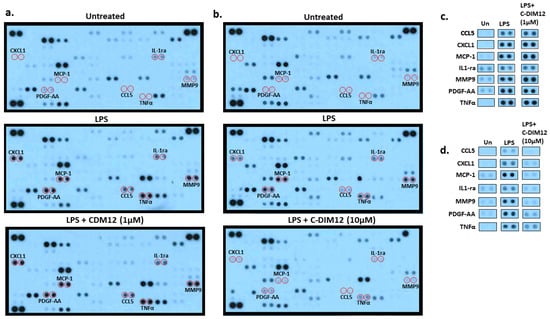
Figure 1
Open AccessReview
Association of Bitter Taste Receptors with Obesity and Diabetes and Their Role in Related Tissues
by
Eisuke Kato and Shota Oshima
Receptors 2023, 2(4), 251-263; https://doi.org/10.3390/receptors2040017 - 05 Dec 2023
Abstract
►▼
Show Figures
Taste 2 receptors (T2Rs) are G-protein-coupled receptors responsible for sensing bitter tastes. Many studies have shown the expression of T2Rs in extraoral tissues and the unique role of T2Rs in each tissue. Single-nucleotide polymorphisms of T2Rs are associated with the risk of obesity
[...] Read more.
Taste 2 receptors (T2Rs) are G-protein-coupled receptors responsible for sensing bitter tastes. Many studies have shown the expression of T2Rs in extraoral tissues and the unique role of T2Rs in each tissue. Single-nucleotide polymorphisms of T2Rs are associated with the risk of obesity and diabetes, and the organs/tissues associated with the development of these metabolic diseases, including the intestine, adipose, muscle, liver, and pancreas, are reported to express T2R genes. This result suggests that T2Rs in extraoral tissues contribute to the development of obesity and diabetes. In this narrative review, we summarize current knowledge of the associations of T2Rs with obesity and diabetes, provide an overview of extraoral tissues that are associated with the development of obesity and diabetes that express T2R genes, and summarize the current knowledge of T2Rs.
Full article
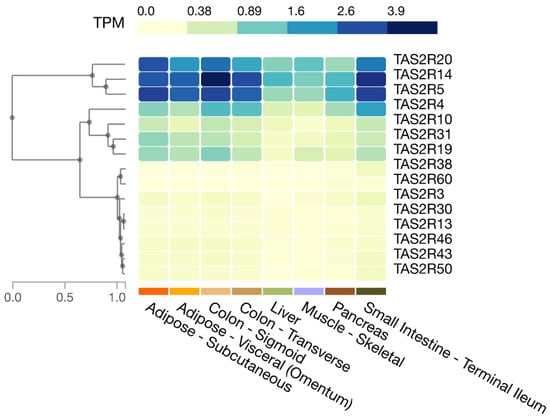
Figure 1
Open AccessFeature PaperReview
Evidence for the Involvement of the Tachykinin NK1 Receptor in Acute Inflammation of the Central Nervous System
by
Renée J. Turner and Alan J. Nimmo
Receptors 2023, 2(4), 232-250; https://doi.org/10.3390/receptors2040016 - 15 Nov 2023
Cited by 1
Abstract
Neuroinflammation is considered to be a significant component in a range of neuropathologies. Unfortunately, whilst its role is well recognised, the options for therapeutic intervention are limited. As such, there is a need to identify novel targets in order to increase treatment options.
[...] Read more.
Neuroinflammation is considered to be a significant component in a range of neuropathologies. Unfortunately, whilst its role is well recognised, the options for therapeutic intervention are limited. As such, there is a need to identify novel targets in order to increase treatment options. Given its role as both a neurotransmitter and an immune modulator, substance P (SP) and its NK1 receptor (NK1R) have been widely studied as a potential therapeutic target. There is evidence that NK1R antagonists may exert beneficial effects in a range of conditions, including traumatic brain injury and stroke. Blocking the NK1R has been shown to reduce blood–brain barrier dysfunction, reduce cerebral oedema, and reduce the levels of pro-inflammatory cytokines. These actions are associated with improved survival and functional outcomes. The NK1R has also been shown to be involved in the inflammatory reaction to CNS infection, and hence antagonists may have some benefit in reducing infection-driven inflammation. However, the NK1R may also play a role in the host immune response to infection, and so here, the potential beneficial and detrimental effects need to be carefully balanced. The purpose of this review is to provide a summary of evidence for the involvement of the NK1R in acute CNS inflammation, particularly in the context of traumatic brain injury and stroke.
Full article
(This article belongs to the Special Issue Biological and Pharmacological Aspects of the Neurokinin-1 Receptor)
►▼
Show Figures
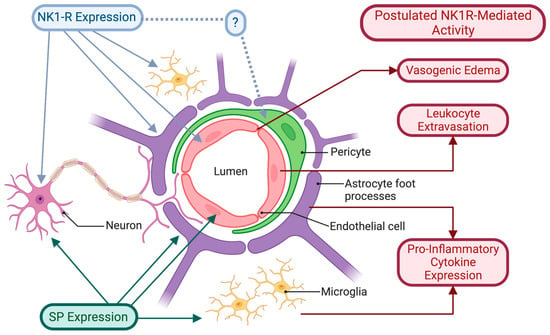
Figure 1
Open AccessReview
The Role of Substance P and NK1 Receptors in Mild to Severe Traumatic Brain Injury: From CTE to ICP
by
Robert Vink and Frances Corrigan
Receptors 2023, 2(4), 220-231; https://doi.org/10.3390/receptors2040015 - 11 Nov 2023
Abstract
Binding of substance P to the tachykinin NK1 receptor is involved in numerous physiological and pathophysiological processes ranging from modulation of sensory and motor function to inflammation, cancer, and brain injury, amongst others. NK1 antagonists therefore have enormous potential as a therapeutic intervention
[...] Read more.
Binding of substance P to the tachykinin NK1 receptor is involved in numerous physiological and pathophysiological processes ranging from modulation of sensory and motor function to inflammation, cancer, and brain injury, amongst others. NK1 antagonists therefore have enormous potential as a therapeutic intervention in a wide variety of human disease states, albeit that the clinical potential is yet to be fully realised. In the current review, the role of substance P in the pathophysiology of traumatic brain injury (TBI) will be discussed, summarising both experimental and clinical observations in mild, moderate, and severe TBI. In addition, the potential for NK1 antagonists to be a valuable therapeutic intervention against chronic traumatic encephalopathy (CTE) after repeated concussive brain injury as well as raised intracranial pressure (ICP) following severe TBI will be addressed, highlighting the various pathophysiological processes that are attenuated by the intervention.
Full article
(This article belongs to the Special Issue Biological and Pharmacological Aspects of the Neurokinin-1 Receptor)
►▼
Show Figures

Figure 1
Open AccessReview
Regulation of Cholesterol Transporters by Nuclear Receptors
by
Michinori Matsuo
Receptors 2023, 2(4), 204-219; https://doi.org/10.3390/receptors2040014 - 09 Oct 2023
Abstract
►▼
Show Figures
Atherosclerosis is a pathological condition characterized by the accumulation of plaques in the arteries, leading to cardiovascular diseases. The deposition of cholesterol in peripheral cells increases the risk of atherosclerosis. Reverse cholesterol transport (RCT) is essential to reduce the risk of atherosclerosis because
[...] Read more.
Atherosclerosis is a pathological condition characterized by the accumulation of plaques in the arteries, leading to cardiovascular diseases. The deposition of cholesterol in peripheral cells increases the risk of atherosclerosis. Reverse cholesterol transport (RCT) is essential to reduce the risk of atherosclerosis because it removes excessive cholesterol from the peripheral tissues. ATP-binding cassette transporters such as ABCA1, ABCG1, ABCG5, and ABCG8 are involved in the efflux of cholesterol. The upregulation of these ABC transporters enhances RCT, thereby promoting the removal of excess cholesterol from the body. The expression and activity of ABC transporters are regulated by transcriptional and post-transcriptional mechanisms, as well as by post-translational modifications. In this review, the regulation of ABC transporters by nuclear receptors such as farnesoid X receptor, liver X receptor, retinoid X receptor, retinoic acid receptor, and peroxisome proliferator-activated receptors is discussed. Pharmacological and natural compounds serving as agonists for the nuclear receptors have been identified to elevate the mRNA levels of the transporters. Consequently, it is anticipated that these compounds will attenuate the development of atherosclerosis through stimulation of the ABC transporters, thereby enhancing RCT and fecal cholesterol excretion. Understanding these regulatory processes can aid in the development of therapeutic approaches to prevent atherosclerosis.
Full article
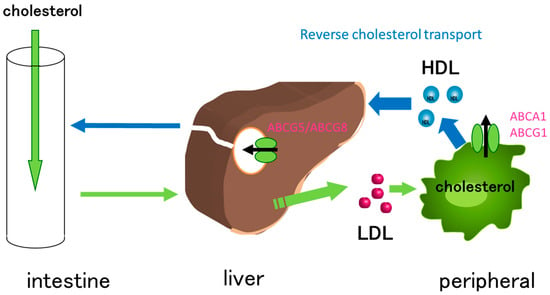
Figure 1
Open AccessBrief Report
Expression of the Purinergic P2X7 Receptor in Murine MOPC315.BM Myeloma Cells
by
Eva Risborg Høyer, Melisa Demir, Lasse Kristoffer Bak, Niklas Rye Jørgensen and Ankita Agrawal
Receptors 2023, 2(3), 191-203; https://doi.org/10.3390/receptors2030013 - 07 Sep 2023
Abstract
►▼
Show Figures
The adenosine-5’ triphosphate (ATP)-gated, ion channel, P2X receptor superfamily has seven members expressed by many cancer types. Subtype 7 (P2X7 receptor) is expressed consistently at levels higher than in comparatively healthy tissues. Moreover, transcript variant heterogeneity is associated with drug resistance. We have
[...] Read more.
The adenosine-5’ triphosphate (ATP)-gated, ion channel, P2X receptor superfamily has seven members expressed by many cancer types. Subtype 7 (P2X7 receptor) is expressed consistently at levels higher than in comparatively healthy tissues. Moreover, transcript variant heterogeneity is associated with drug resistance. We have previously described the role of the P2X7 receptor in myeloma, a rare blood disease that uniquely presents with aggressive bone destruction. In this study, we used known agonists of the P2X7 receptor to induce calcium influx and YO-PRO-1 uptake in murine MOPC315.BM myeloma cells as readouts of P2X7 receptor-mediated channel activation and pore formation, respectively. Neither ATP- nor BzATP-induced calcium influx and YO-PRO-1 indicated an absence of the P2X7 receptor function on MOPC315.BM cells. TaqMan revealed low (Ct > 35) P2rx7 but high P2rx4 gene expression in MOPC315.BM; the latter was downregulated with BzATP treatment. The concomitant downregulation of CD39/Entpd1, Icam-1, and Nf-kb1 and the upregulation of Casp-1 genes regulated during purinergic signaling and with established roles in myeloma progression suggest P2RX4-mediated survival adaptation by cancer cells. Further studies are needed to characterize the P2RX4 pharmacology on MOPC315.BM since transcriptional regulation may be utilized by cancer cells to overcome the otherwise toxic effects of high extracellular ATP.
Full article
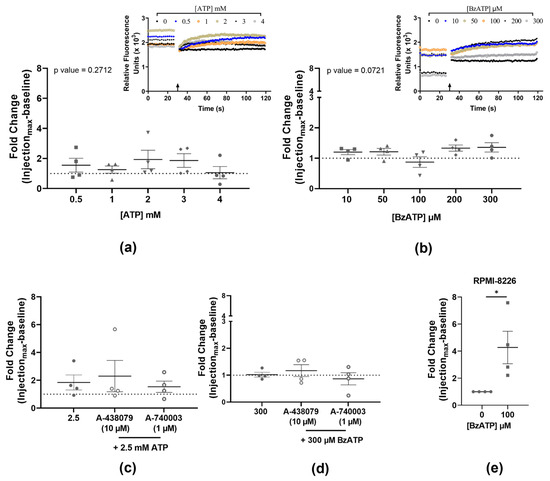
Figure 1
Open AccessFeature PaperArticle
Estrogen Receptor β Isoforms Regulate Chemotherapy Resistance and the Cancer Stem Cell Population in Prostate Cancer Cells
by
Jessica H. Stevens, Ayesha Bano, Lamia Bensaoula, Anders M. Strom and Jan-Åke Gustafsson
Receptors 2023, 2(3), 176-190; https://doi.org/10.3390/receptors2030012 - 01 Aug 2023
Cited by 1
Abstract
Estrogen receptor beta 1 (ERβ1) is a ligand-activated nuclear receptor, which has been shown to maintain tissue differentiation in the normal prostate, and regulate androgen response and increase expression of tumor suppressors in prostate cancer cell lines. There are three shorter isoforms of
[...] Read more.
Estrogen receptor beta 1 (ERβ1) is a ligand-activated nuclear receptor, which has been shown to maintain tissue differentiation in the normal prostate, and regulate androgen response and increase expression of tumor suppressors in prostate cancer cell lines. There are three shorter isoforms of ERβ expressed in the human prostate, ERβ2, ERβ4, and ERβ5, which have already been implicated in chemotherapy resistance and disease progression, suggesting a possible oncogenic role. Their ligand-binding domain (LBD) is truncated, so they are unable to activate canonical ERβ1 signaling pathways; however, they were shown to participate in hypoxic signaling and to induce a gene expression signature associated with stemness and hypoxia. To elucidate the role of the truncated ERβ isoforms in prostate cancer, we created a knockout of all isoforms, as well as a truncation of the LBD, to remove the function of ERβ1. We showed that the removal of all isoforms leads to a decrease in the expression of cancer stem cell (CSC)-associated genes, decreased chemotherapy resistance, and a decrease in the CSC population, based on sphere formation ability and SORE6 (CSC reporter) activity, while removing the LBD function only had the opposite effect. Our results suggest a more aggressive phenotype in prostate cancer cell lines expressing ERβ variants.
Full article
(This article belongs to the Special Issue Nuclear Receptors: Honorary Special Issue Commemorating the Work of Prof. Jan-Åke Gustafsson)
►▼
Show Figures
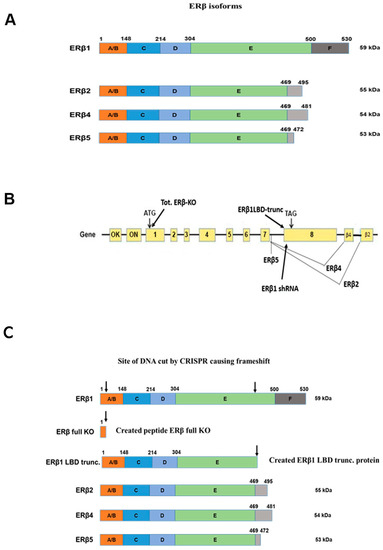
Figure 1
Open AccessOpinion
From Antibodies to Crystals: Understanding the Structure of the Glucocorticoid Receptor and Related Proteins
by
Iain J. McEwan
Receptors 2023, 2(3), 166-175; https://doi.org/10.3390/receptors2030011 - 03 Jul 2023
Cited by 1
Abstract
The steroid/thyroid hormone or nuclear receptor superfamily is quickly approaching its 40th anniversary. During this period, we have seen tremendous progress being made in our understanding of the mechanisms of action of these physiologically important proteins in the field of health and disease.
[...] Read more.
The steroid/thyroid hormone or nuclear receptor superfamily is quickly approaching its 40th anniversary. During this period, we have seen tremendous progress being made in our understanding of the mechanisms of action of these physiologically important proteins in the field of health and disease. Critical to this has been the insight provided by ever more detailed structural examination of nuclear receptor proteins and the complexes they are responsible for assembling on DNA. In this article, I will focus on the contributions made by Jan-Åke Gustafsson and colleagues at the Karolinska Institute (Sweden) and, more recently, the University of Houston (USA), to this area of nuclear receptor research.
Full article
(This article belongs to the Special Issue Nuclear Receptors: Honorary Special Issue Commemorating the Work of Prof. Jan-Åke Gustafsson)
►▼
Show Figures
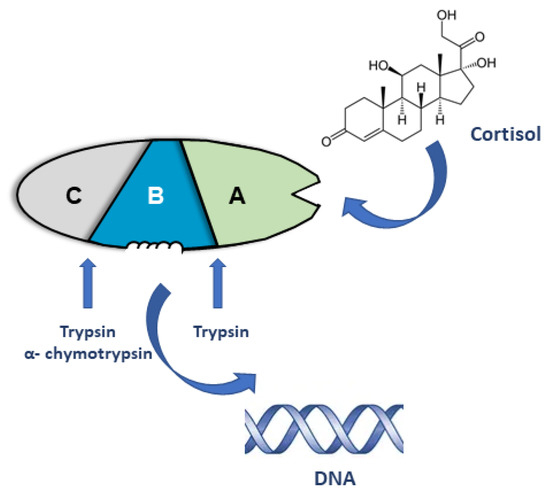
Figure 1
Open AccessCommunication
Cycle Numbers of Cell Surface Recycling Receptors
by
Dietmar Steverding
Receptors 2023, 2(2), 160-165; https://doi.org/10.3390/receptors2020010 - 06 Jun 2023
Cited by 1
Abstract
►▼
Show Figures
The cycle number (nc) of a recycling receptor is defined as the average number of round trips (cell surface–endosome–cell surface) the receptor can make before it is degraded. This characteristic parameter of recycling receptors can be easily determined from the
[...] Read more.
The cycle number (nc) of a recycling receptor is defined as the average number of round trips (cell surface–endosome–cell surface) the receptor can make before it is degraded. This characteristic parameter of recycling receptors can be easily determined from the receptor’s half-life (t½, the time in which 50% of the receptor is degraded) and cycling time (Tc, the time a receptor needs to complete a round trip). Relationship analyses revealed that nc increases linearly with increasing t½ and decreases exponentially with increasing Tc. For commonly observed t½ and Tc values, it was calculated that recycling receptors have nc values of <300. In addition, it was found that recycling receptors in cancer cells have generally smaller nc values (<100), whereas recycling receptors in normal cells have larger nc values (>100). Based on this latter finding, the cycle number nc may be a useful criterion for distinguishing between cancer and normal cells.
Full article
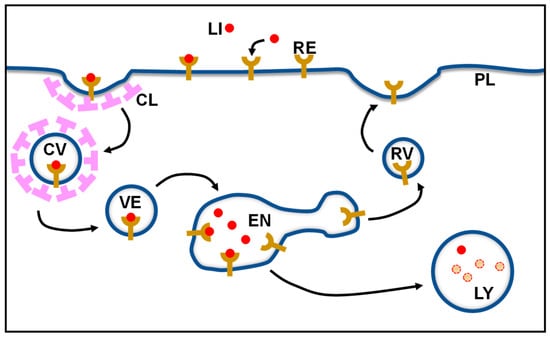
Figure 1
Open AccessCommunication
Analysis of Cell–Cell Communication by Single-Nuclei RNA Sequencing Identifies AHR-Mediated Induction of NRG-ERBB Signaling
by
Rance Nault, Giovan N. Cholico and Tim Zacharewski
Receptors 2023, 2(2), 148-159; https://doi.org/10.3390/receptors2020009 - 11 May 2023
Cited by 1
Abstract
Communication between cells is essential in maintaining homeostasis. The persistent disruption of cell–cell communication by environmental contaminants contributes to progressive disease and toxicity. In this study, single-nuclei RNA sequencing (snRNAseq) data was used to examine dose-dependent cell-specific changes in cell–cell communication associated with
[...] Read more.
Communication between cells is essential in maintaining homeostasis. The persistent disruption of cell–cell communication by environmental contaminants contributes to progressive disease and toxicity. In this study, single-nuclei RNA sequencing (snRNAseq) data was used to examine dose-dependent cell-specific changes in cell–cell communication associated with the development of liver pathologies following the persistent activation of the aryl hydrocarbon receptor (AHR) by 2,3,7,8-tetrachlorodibenzo-p-dioxin (TCDD). Published hepatic snRNAseq data from male mice gavaged with sesame-oil vehicle or TCDD every 4 days for 28 days was used to assess the AHR-mediated disruption of ligand–receptor interactions. Analysis identified that portal fibroblasts and liver sinusoidal endothelial cells contributed the most ligand–receptor pairs at doses < 0.3μg/kg TCDD. Doses ≥ 0.3 μg/kg TCDD increased the putative intercellular communication between hepatocytes and hepatic stellate cells. In control livers, interactions primarily consisted of protease-activated receptor (PAR) signaling. TCDD treatment increased the number of active signaling pathways. Within hepatocytes, neuregulin signaling was induced, activating the NRG1–ERBB4 ligand axis, consistent with AHR genomic enrichment at dioxin response elements in a published chromatin immunoprecipitation sequencing (ChIP-seq) dataset, which suggested a direct regulation. Collectively, the results suggest that the disruption of cell signaling may play a central role in TCDD-elicited liver pathologies.
Full article
(This article belongs to the Special Issue Selected Papers from the AHR Symposium 2022)
►▼
Show Figures

Figure 1
Open AccessReview
Molecular Characterization and Pharmacology of Melatonin Receptors in Animals
by
Erika Cecon, Jean A. Boutin and Ralf Jockers
Receptors 2023, 2(2), 127-147; https://doi.org/10.3390/receptors2020008 - 14 Apr 2023
Cited by 5
Abstract
►▼
Show Figures
Melatonin, the hormone of darkness, is secreted in minute amounts during the night and is virtually undetectable during the day. Melatonin mainly acts on high-affinity G protein-coupled receptors. The present review will trace the path of the discovery of melatonin receptors from their
[...] Read more.
Melatonin, the hormone of darkness, is secreted in minute amounts during the night and is virtually undetectable during the day. Melatonin mainly acts on high-affinity G protein-coupled receptors. The present review will trace the path of the discovery of melatonin receptors from their cloning, expression and purification to the development of recent radioactive and fluorescent tracers. We will then report on the state-of-the-art of melatonin receptor functional properties, including ligand bias and system bias due to receptor-associated proteins and receptor heteromers. Currently available antibodies raised against melatonin receptors will be critically reviewed here for the first time. The review will close with future perspectives in terms of the discovery of allosteric ligands and the in vivo validation of a range of melatonin receptor-associated signaling complexes to improve future drug development.
Full article
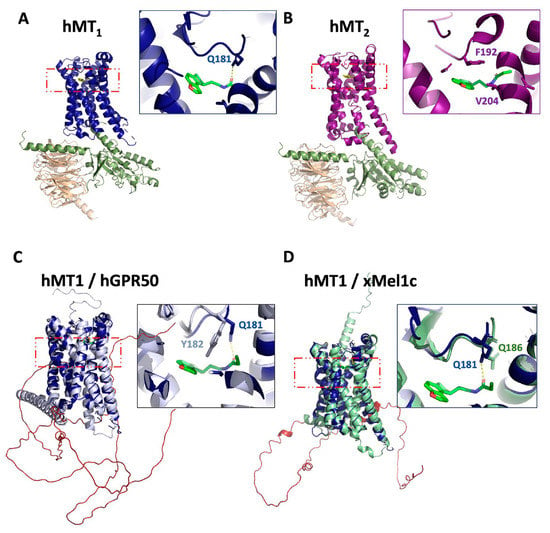
Figure 1
Highly Accessed Articles
Latest Books
E-Mail Alert
News
Topics

Conferences
Special Issues
Special Issue in
Receptors
Biological and Pharmacological Aspects of the Neurokinin-1 Receptor
Guest Editors: Rafael Coveñas Rodríguez, Miguel MuñozDeadline: 30 June 2024
Special Issue in
Receptors
Nicotinic Receptors: From Molecule to Benchside
Guest Editor: Yousef TizabiDeadline: 15 October 2024



